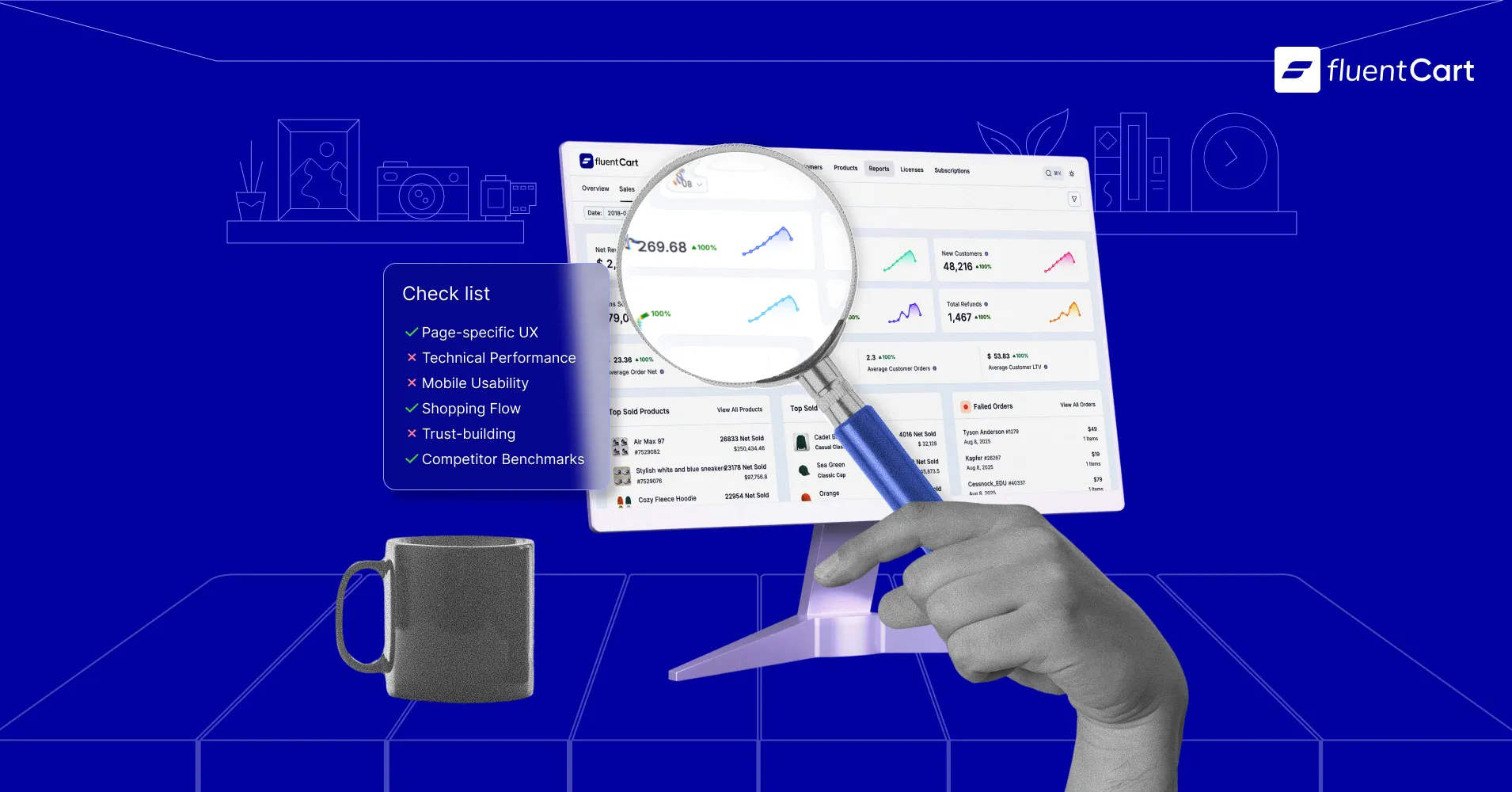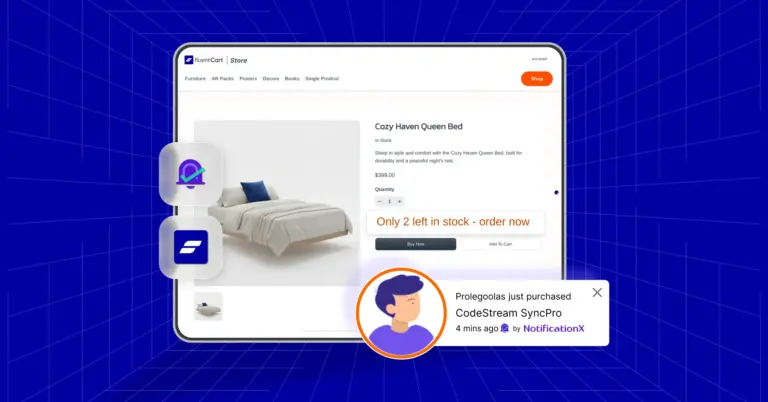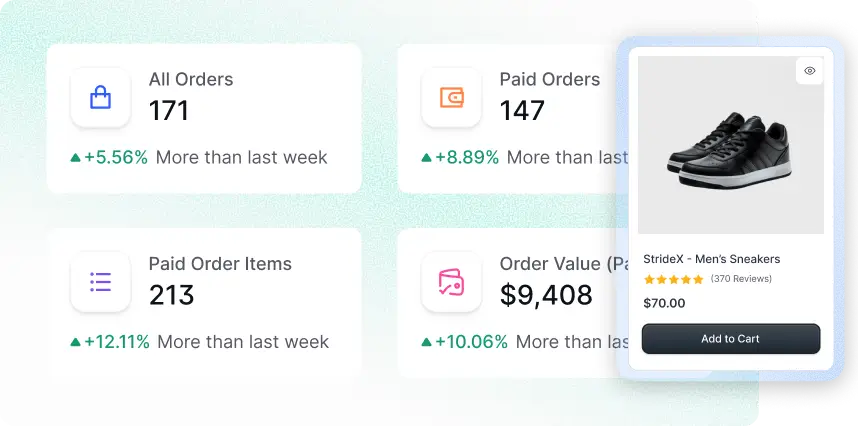eCommerce CRO Audit Guide + Free Template (2025)

Is your store getting traffic but not enough sales? You’re not alone.
The global average eCommerce conversion rate is around 2.35%. That means nearly 97 out of every 100 visitors leave without buying. A CRO audit helps you fix that.
A good audit can help you resolve hidden issues like slow load times, confusing copy, or weak CTAs that quietly kill conversions. I’ve previously used an eCommerce CRO audit formula with dozens of stores and helped them boost their conversion rates by up to 50% in less than 90 to 180 days.
In this guide, you’ll learn how to run your own conversion rate optimization audit, with 6 focus areas. You’ll also get access to a detailed free audit checklist and progress summary template, so you can take action as you read.

What Is an eCommerce CRO Audit?
Definition: An eCommerce CRO audit is a detailed review of your online store that identifies what’s stopping visitors from becoming customers. It looks at key factors like website speed, mobile experience, product pages, checkout process, and so on.
The audit process combines quantitative data (analytics, metrics, performance scores) with qualitative insights (user behavior, feedback, usability testing). This is to create a comprehensive picture of your store’s conversion performance.
Unlike general website audits that focus on a website’s technical issues, CRO audits specifically target revenue-generating improvements.
If you want to skip the prep section and go straight to what you’ll audit.
Jump to Focus Areas
Things to Know Before You Get Started
Many CRO audits fail because they jump in without clear goals, proper tools, or a solid documentation of the business context. They often get lost in surface-level fixes or overwhelm themselves by trying to do too much at once.
Before you start your audit, it’s crucial to prepare thoughtfully. This will keep your efforts focused, efficient, and effective.
Have a Clear Goal
Clearly define what you’re trying to achieve with this audit. Are you trying to:
- Increase average order value (AOV)?
- Reduce cart abandonment?
- Improve conversions for a new product line?
- Boost sales from mobile traffic?
Tie your audit goals directly to business objectives. For example, if your goal is to push sales for a specific product line, your CRO efforts should prioritize optimizing those product pages, adjusting CTAs across the site, and analyzing their funnel performance.
Allocate Your Time
A complete CRO audit for a small to medium-sized eCommerce store typically requires 40 to 60 hours to complete. To make the most of your own time, it’s helpful to divide these hours by priority.
For example, allocate 15 to 20 hours for assessing technical site performance, another 15 to 20 hours to analyze user behavior and conversion funnels. Use the remaining time for testing and reviewing improvements.
Setup Essential Tools
Ensure you have all the essential tools for data collection setup in place:
- Google Analytics 4 with Enhanced eCommerce tracking enabled
- Google Search Console for organic traffic insights
- Heatmap tool & Session recordings (Microsoft Clarity, Hotjar, or similar) to observe actual user behavior
Gather Business Context
Document these critical details on a spreadsheet before starting:
- Current conversion rate benchmarks
- Primary business objectives (AOV, volume, specific products)
- Target audience demographics and behavior patterns
- Seasonal trends or recent changes that might affect data

6 Focus Areas for eCommerce CRO Audits
Every conversion rate optimization audit is unique to the structure and strategy of your store, but here are 6 core focus areas to guide your next eCommerce CRO audit:
- Technical Performance
- Page-Specific UX
- Mobile Usability
- Shopping Flow
- Trust-Building Elements
- Competitor Benchmarking
1. Technical Performance
What You’re Evaluating: Site speed, Core Web Vitals, mobile responsiveness, security, and basic functionality that supports conversions.
Why This Matters First: Technical issues create immediate barriers. A slow site or broken checkout process will kill conversions regardless of how compelling your product is.
How to Conduct This Audit
Site Speed Analysis
- Test your homepage and top 5 product pages using Google PageSpeed Insights
- Record both mobile and desktop scores
- Use GTmetrix for detailed performance breakdown
- Test actual load times from different geographic locations
Mobile Responsiveness Check
- Navigate your entire purchase flow using only mobile devices
- Test on both iOS and Android devices
- Verify all forms, buttons, and interactive elements work properly
- Check text readability without zooming
Functionality Testing
- Complete a test purchase from start to finish
- Verify all payment methods process correctly
- Test contact forms and customer service features
- Check for broken links, missing images, or error pages
Security Verification
- Confirm SSL certificate is properly installed and displaying
- Verify payment security badges are visible during checkout
- Check for mixed content warnings
- Ensure privacy policy and terms are easily accessible
Red Flags to Watch For
- Mobile page load times over 3 seconds
- Desktop scores below 70 in PageSpeed Insights
- Any broken functionality in the checkout process
- Missing or expired security certificates
2. Page-Specific UX
What You’re Evaluating: User experience on critical pages. Example: Homepage, product pages, cart, and checkout, and how visitors navigate between them.
Why Page-Level UX Determines Conversions: Each page in your conversion funnel serves a specific purpose. Homepage builds trust and guides discovery, product pages convince visitors to buy, and checkout pages finalize the sale. Weak UX at any stage breaks the entire funnel.
How to Conduct This Audit
Homepage UX Assessment
- Test the 5-second rule: Show your homepage to someone new. Can they explain what you sell within 5 seconds?
- Evaluate value proposition clarity and positioning above the fold
- Check navigation structure and product category organization
- Assess search functionality prominence and effectiveness
- Review featured products, promotions, and trust signals placement
Product Page UX Evaluation
Product Discovery and Navigation:
- Test product filtering and sorting functionality
- Verify category pages load properly and display complete information
- Check breadcrumb navigation and “back to category” functionality
- Assess related product recommendations and cross-selling elements
Individual Product Page Analysis:
- Evaluate product image quality, zoom functionality, and gallery navigation
- Review product description clarity, benefit focus, and specification completeness
- Check size guides, measurement tools, and customization options
- Assess review integration, Q&A sections, and social proof elements
- Test “Add to Cart” button visibility, positioning, and functionality
Cart Page UX Review
- Test cart persistence across sessions and devices
- Evaluate quantity editing, item removal, and cart updating functionality
- Check shipping calculator and cost transparency
- Review cart abandonment recovery elements (save for later, email capture)
- Assess cross-sell and upsell opportunities within cart experience
Checkout Page UX Analysis
- Document number of steps and required fields
- Test guest checkout availability and account creation flow
- Evaluate form field organization and mobile-friendly design
- Check payment option variety and security indicator visibility
- Test error handling and validation messaging
Critical UX Issues to Identify
- Pages where users seem confused or spend excessive time without action
- Navigation elements that don’t match user expectations
- Content that doesn’t answer key questions at the right moment
- Inconsistent experience between similar page types
3. Mobile Usability
What You’re Evaluating: Thumb-friendly design, form completion ease, mobile-specific navigation, and the complete mobile shopping experience.
Why Mobile Usability Is Critical: “Mobile accounts for over 54% of global eCommerce traffic but typically converts at lower rates than desktop.” The gap represents massive revenue opportunity.
How to Conduct This Audit
Navigation and Interface Testing
Thumb-Friendly Design Assessment:
- Test all buttons and links using only thumbs on actual mobile devices
- Verify touch targets meet minimum 44px standard
- Check spacing between clickable elements to prevent accidental taps
- Test menu accessibility and dropdown functionality
Mobile Form Completion Analysis:
- Complete entire checkout process using only mobile device
- Test keyboard behavior for different input types (email, phone, address)
- Verify auto-complete and auto-correct functionality works properly
- Check form validation and error messaging visibility
Shopping Experience Evaluation
Product Discovery on Mobile:
- Test product search functionality and results display
- Evaluate filter and sort options usability
- Check product image galleries and zoom functionality
- Assess product comparison capabilities on small screens
Mobile Checkout Flow:
- Time the mobile checkout process from cart to completion
- Test payment method selection and input fields
- Verify guest checkout availability and ease of use
- Check mobile-specific payment options (Apple Pay, Google Pay)
Performance and Behavior
Use mobile-specific analytics to identify,
- Pages with highest mobile bounce rates
- Mobile vs. desktop conversion rate gaps
- Mobile user behavior patterns and preferences
- Device-specific technical issues
Red Flags to Watch For
- Mobile conversion rates significantly lower than desktop
- High mobile bounce rates on key pages
- Touch targets smaller than 44px or poorly spaced
- Forms that are difficult to complete on mobile devices
4. Shopping Flow
What You’re Evaluating: The complete cart-to-checkout journey, identifying friction points, abandonment causes, and flow optimization opportunities.
Why Shopping Flow Determines Revenue: “More than 70% of shopping carts are abandoned.” Even small improvements in this flow can recover thousands in lost revenue.
How to Conduct This Audit
Cart Functionality and User Experience
Persistence and Management:
- Test cart saving across different browsers and devices
- Verify items remain in cart between sessions
- Check cart recovery for logged-in vs. guest users
- Test cart synchronization across multiple devices
Editing and Transparency:
- Test quantity adjustment functionality and real-time updates
- Verify item removal works properly and provides clear feedback
- Check shipping cost calculation and display timing
- Review tax calculation transparency and timing
- Assess promo code functionality and error handling
Checkout Process Flow Analysis
Checkout Initiation:
- Count and time each step in checkout process
- Test guest checkout availability and ease of access
- Verify account creation is optional, not required
- Check checkout loading times and progress indicators
Information Collection Process:
- Document all required vs. optional fields
- Test form auto-completion and validation
- Check address verification and suggestion features
- Verify payment information collection is secure and clear
Abandonment Point Identification
Use analytics and heatmaps to identify:
- Specific steps where users most commonly abandon
- Form fields that cause hesitation or confusion
- Payment method selection issues
- Shipping option decision points
Session Recording Analysis:
- Watch recordings of users who abandoned during checkout
- Identify common hesitation points and confusion areas
- Document unexpected user behavior during checkout flow
- Note where users attempt actions that don’t work
Flow Optimization Opportunities
- Checkout steps that can be combined or simplified`
- Information requests that can be moved or made optional
- Payment and shipping options that need clearer presentation
- Trust signals that should be added at decision points
5. Trust-Building Elements
What You’re Evaluating: Reviews, guarantees, return policies, security indicators, and credibility signals that influence purchase confidence.
Why Trust Signals Determine Conversion: “88% of consumers trust online reviews as much as personal recommendations.” Without trust signals, you’re asking customers to take unnecessary risks.
How to Conduct This Audit
Customer Review and Social Proof Analysis
Review System Assessment:
- Check review visibility and prominence on product pages
- Verify review recency and quantity across product lines
- Assess review authenticity indicators (verified purchases, reviewer profiles)
- Test review sorting and filtering functionality
- Document photo/video review integration
Social Proof Integration:
- Evaluate customer testimonial placement and quality
- Check user-generated content usage (photos, videos, social media)
- Assess influencer collaborations and endorsements display
- Review case studies and success story integration
Security and Credibility Indicators
Security Signal Evaluation:
- Document all security badges and their placement (SSL, McAfee, Norton, etc.)
- Check security certificate validity and proper display
- Verify payment security indicators during checkout
- Assess data privacy and security policy accessibility
Business Credibility Assessment:
- Review “About Us” page completeness and authenticity
- Check team photos and company story presentation
- Verify contact information completeness (phone, address, email)
- Assess business registration and certification displays
Guarantee and Policy Transparency
Return and Refund Policy Review:
- Check policy accessibility and clarity
- Assess return timeframe communication
- Verify return process explanation and ease
- Review refund processing time transparency
Product and Service Guarantees:
- Document money-back guarantees and their prominence
- Check warranty information display and clarity
- Assess satisfaction guarantee communication
- Review any risk-free trial offers
Opportunities to Identify
- Missing security indicators at critical decision points
- Weak or unclear guarantee and return policy communication
- Insufficient social proof integration
- Credibility gaps that competitors are addressing better
6. Competitor Benchmarking
What You’re Evaluating: How your store compares to successful competitors and industry leaders across all previous focus areas.
Why Competitive Benchmarking Is Essential: Your customers compare you to competitors constantly. Understanding where you stand reveals critical improvement opportunities and competitive advantages.
How to Conduct This Audit
Competitor Identification and Analysis Setup
Strategic Competitor Selection:
- Identify 3-5 direct competitors with similar products, pricing, and target audience
- Include 1-2 industry leaders or aspirational benchmarks
- Select competitors with strong online presence and apparent success metrics
- Document each competitor’s market position and differentiation
Comprehensive Competitive Assessment:
- Complete full purchase journeys on each competitor site
- Document user experience across all 5 previous focus areas
- Screenshot and record key processes and features
- Note unique approaches, innovations, and industry best practices
Focus Area Benchmarking
Technical Performance Comparison:
- Compare page load speeds using same testing tools
- Assess mobile responsiveness and technical functionality
- Document Core Web Vitals performance differences
- Note any technical advantages competitors have
Page-Specific UX Benchmarking:
- Compare homepage value proposition and navigation
- Assess product page layout, information, and conversion elements
- Document checkout process differences and complexity
- Note superior UX approaches used by competitors
Mobile Experience Comparison:
- Test mobile usability across all competitor sites
- Document mobile-specific features and optimizations
- Compare mobile checkout processes and form designs
- Identify mobile experience gaps and opportunities
Shopping Flow Analysis:
- Document competitor cart and checkout processes
- Time complete purchase flows and count steps
- Note abandonment recovery strategies and guest checkout options
- Identify superior flow optimizations
Trust Signal Benchmarking:
- Compare review systems and social proof integration
- Document security badges and credibility indicators
- Assess guarantee and policy presentation
- Note trust-building strategies you’re missing
Competitive Gap and Opportunity Analysis
Create detailed comparison documenting,
- Areas where competitors significantly outperform your store
- Unique advantages you have over competitors
- Industry standard features or approaches you’re missing
- Innovative practices that could be adapted to your business
Strategic Insights to Extract
- Which focus areas show the biggest competitive gaps?
- What industry standards are you failing to meet?
- Where do you have clear competitive advantages to leverage?
- What innovative approaches could differentiate your store?
Document, Act, Measure
Start by recording your business goals, key data, and baseline metrics on a spreadsheet. This helps keep your work focused. Next, list all audit checkpoints based on the six focus areas.
Include columns for status, notes, priority, recommended fixes, owner, due dates, and completion. Track progress in another sheet, and use the final sheet to compare before-and-after results.
Once you finish the audit, create an action plan. Prioritize issues by how much they affect revenue and how hard they are to fix. Focus first on high-impact, easy fixes.
Plan carefully for high-impact but complex issues. Low-impact, easy fixes can fill gaps. Skip low-impact, complex ones. This keeps your efforts efficient and effective.
To measure success, track key metrics like overall conversion rate, revenue per visitor, and cart abandonment. Also watch page-level conversions, user engagement, and customer value.
Monitor technical scores and user experience improvements too. These numbers prove if your audit made a real difference and guide your next steps.

Wrapping Up
Your traffic already contains hidden revenue. This 6 focus area based audit framework showed you exactly how to find it. Start with any area based on your priority this week, work through each area systematically, and prioritize high-impact fixes first.
While competitors ignore systematic optimization, you’ll have data-driven insights driving real revenue growth.
Wishing you smooth audits and big wins!









Leave a Reply